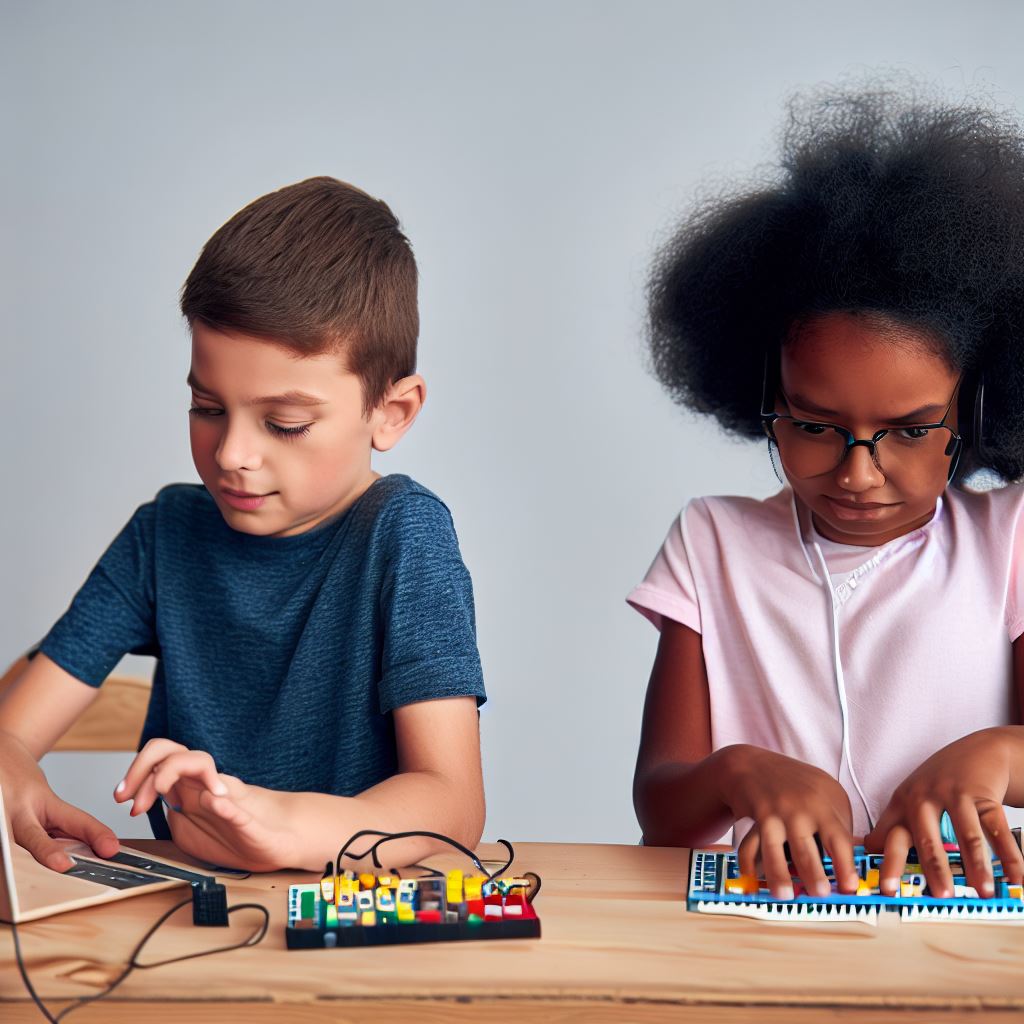Introduction
Importance of inclusive coding practices for children with special needs
Inclusive coding practices are crucial in ensuring that children with special needs can participate fully in programming activities.
These practices aim to create an environment where all children, regardless of their abilities, can engage with coding.
By including children with special needs, we promote diversity and eliminate barriers that may prevent them from developing their coding skills and accessing future opportunities.
Explanation of the purpose of the blog post
This blog post aims to shed light on the importance of inclusive coding practices for children with special needs. It will explore the benefits of including these children in coding activities and provide strategies and resources to support their learning.
By sharing information and resources, we hope to encourage educators and parents to create inclusive coding environments that cater to the diverse needs of all children.
Together, we can foster equal learning opportunities and empower children with special needs to explore the world of coding. Stay tuned for practical tips and insights on how to make coding accessible to all children!
Understanding Special Needs and Coding
Definition and overview of special needs
Special needs refer to the requirements or challenges faced by individuals who have physical, developmental, or cognitive disabilities. These disabilities may affect their ability to learn, communicate, or interact with others.
Special needs can encompass a wide range of conditions, including autism spectrum disorder, attention deficit hyperactivity disorder (ADHD), Down syndrome, dyslexia, and cerebral palsy, among others. Each condition presents unique difficulties and learning styles.
It is important to understand that individuals with special needs are capable of learning and have unique talents and skills. They simply require extra support and accommodations to reach their full potential.
Benefits of coding for children with special needs
Coding provides an inclusive learning opportunity for children with special needs. It offers various benefits that can enhance their overall development and quality of life.
1. Enhances problem-solving skills
Coding involves logical thinking, analyzing situations, and finding solutions. These skills are valuable for children with special needs as they improve their problem-solving abilities in various aspects of life.
2. Promotes creativity and self-expression
Through coding, children can unleash their creativity by designing and building interactive projects. It allows them to express themselves and showcase their unique ideas and talents.
3. Develops critical thinking and focus
Coding requires attention to detail, critical thinking, and the ability to break down complex problems into smaller parts. Engaging in coding activities can improve children’s focus and concentration skills.
4. Encourages collaboration and social skills
Coding classes or clubs provide opportunities for children with special needs to collaborate with peers. Working together on coding projects fosters teamwork, communication, and social interaction skills.
5. Boosts confidence and self-esteem
Successfully solving coding challenges and creating projects can boost children’s confidence and self-esteem. It empowers them to believe in their abilities and overcome the barriers they face.
Tech Consulting Tailored to Your Coding Journey
Get expert guidance in coding with a personalized consultation. Receive unique, actionable insights delivered in 1-3 business days.
Get StartedChallenges and barriers faced by children with special needs in coding
While coding offers numerous benefits, children with special needs may encounter challenges and barriers that affect their participation and progress in coding activities.
1. Lack of accessible resources and tools
Not all coding platforms and resources are designed to be fully accessible for children with special needs. Limited availability of assistive technologies and adapted materials can hinder their learning experience.
2. Difficulties with abstract concepts
Some children with special needs may struggle with abstract thinking and understanding complex coding concepts. It may require additional support and alternative teaching methods to help them grasp the content.
3. Sensory sensitivities and environmental factors
Children with special needs, such as those with autism, may have sensory sensitivities that make it challenging to engage in coding activities. Background noise, bright lights, or certain textures can distract or overwhelm them.
4. Individual learning pace and styles
Children with special needs may require more time to process information, understand instructions, or complete coding tasks. Their individual learning pace and styles must be considered to provide appropriate support and accommodations.
5. Limited access to qualified instructors
Finding qualified instructors who have expertise in both coding and special education can be a challenge. Lack of specialized guidance and support can hinder the progress and development of children with special needs in coding.
Despite these challenges, it is crucial to create inclusive coding environments that prioritize the unique needs and strengths of children with special needs. By addressing these barriers, coding can become a transformative learning tool for all children, regardless of their abilities.
Read: 10 Common HTML Mistakes and How to Avoid Them
Inclusive Coding Strategies for Kids with Special Needs
- Provide visual coding options: Use visual coding platforms and tools to make coding accessible for kids with special needs.
- Utilize auditory coding platforms: Incorporate coding platforms that use sound and oral instructions to engage children with special needs.
- Incorporate tactile coding activities: Create hands-on coding activities using tangible objects to stimulate learning for kids with special needs.
- Implement adaptive technology and tools: Use adaptive technology and tools that can assist children with special needs in coding activities.
- Offer individualized support and accommodations: Provide personalized assistance and accommodations to cater to the specific needs of each child.
Coding can be a fun and beneficial activity for all children, including those with special needs. By implementing inclusive coding strategies, educators and parents can ensure that every child has the opportunity to learn and thrive in this digital age.
Provide visual coding options
Visual coding options are ideal for children with special needs who are visual learners or have difficulty processing auditory information.
Platforms such as Scratch and Blockly provide visual representations of code that can be easily understood and manipulated. These platforms offer drag-and-drop features, allowing children to arrange code blocks visually.
This visual approach to coding helps children with special needs grasp programming concepts and develop problem-solving skills in a way that suits their learning style.
Utilize auditory coding platforms
For children with special needs who are auditory learners or have visual impairments, auditory coding platforms can be highly effective.
These platforms use sound and oral instructions to guide children through coding activities. By listening to instructions and verbalizing their code, children can enhance their auditory processing skills while engaging in coding.
Build Your Vision, Perfectly Tailored
Get a custom-built website or application that matches your vision and needs. Stand out from the crowd with a solution designed just for you—professional, scalable, and seamless.
Get StartedPlatforms like Code.org and CodeMonkey provide auditory coding options, enabling children with special needs to actively participate in coding lessons.
Incorporate tactile coding activities
Tactile coding activities utilize hands-on materials to engage children with special needs. By incorporating tangible objects such as programmable robots or coding kits, educators can create a multisensory coding experience.
Children with special needs can touch and manipulate physical objects, enhancing their understanding of coding concepts. These tactile coding activities promote fine motor skills, spatial awareness, and problem-solving abilities.
Tools like Cubetto and LEGO Education Spike Prime are designed to provide tactile coding experiences for children with special needs.
Implement adaptive technology and tools
Adaptive technology and tools play a crucial role in making coding accessible for children with special needs. These technologies can accommodate various disabilities, such as visual impairments or fine motor difficulties.
Screen readers, enlarged keyboards, and alternative input devices enable children with special needs to overcome barriers and actively participate in coding activities.
Software programs like Swift Playgrounds and Blockly for Dash & Dot are compatible with adaptive technology, making coding inclusive for all children.
Offer individualized support and accommodations
Every child with special needs is unique, requiring personalized support and accommodations.
Educators and parents should provide individualized assistance to ensure that each child can fully engage in coding activities. This may involve modifying lesson plans, offering additional time for assignments, or providing one-on-one support.
Creating a supportive and inclusive environment is essential for children with special needs to thrive in coding.
By tailoring their approach to each child’s specific needs, educators and parents can foster a love for coding and empower children with special needs to become successful programmers.
Basically, inclusive coding strategies can make coding accessible and enjoyable for children with special needs.
By providing visual coding options, utilizing auditory coding platforms, incorporating tactile activities, implementing adaptive technology, and offering individualized support, educators and parents can ensure that every child has the opportunity to learn and excel in coding.
Let us embrace inclusivity and empower all children to unlock their potential through coding.
Optimize Your Profile, Get Noticed
Make your resume and LinkedIn stand out to employers with a profile that highlights your technical skills and project experience. Elevate your career with a polished and professional presence.
Get NoticedRead: Behind the Screens: A Day in the Life of a USA-based Coding Ninja

Creating an Inclusive Coding Environment
Promote a supportive and accepting classroom culture
- Create an environment where all students feel safe and valued, regardless of their abilities.
- Encourage students to respect and celebrate each other’s differences.
- Implement inclusive language and promote positive interactions among peers.
- Provide opportunities for students to share their experiences and perspectives.
Encourage collaboration and peer learning
- Design coding activities that promote teamwork and cooperation.
- Pair students with different abilities to work together on projects.
- Encourage students to support and assist each other during coding exercises.
- Foster a sense of belonging and encourage students to contribute their unique skills.
Foster a growth mindset and celebrate progress
- Teach students that intelligence and abilities can be developed through effort and practice.
- Provide feedback that focuses on effort, progress, and improvement rather than solely on end results.
- Recognize and celebrate small achievements to build confidence and motivation.
- Encourage students to set personal goals and track their progress over time.
Address concerns related to behavior and attention difficulties
- Implement clear and consistent behavior expectations and consequences.
- Provide visual cues and reminders to help students stay on task.
- Break coding activities into smaller, manageable tasks to accommodate students with attention difficulties.
- Offer alternative learning spaces or tools for students who require additional support.
Creating an inclusive coding environment involves cultivating a classroom culture where all students feel supported, respected, and engaged.
By promoting a supportive and accepting classroom culture, students with special needs can comfortably participate in coding activities and feel a sense of belonging.
Encouraging collaboration and peer learning: A crucial aspect of inclusivity in coding education. Pairing students with different abilities together encourages teamwork, allows for the exchange of ideas, and promotes a sense of shared learning.
By working collaboratively, students can develop a deeper understanding of coding concepts and build stronger relationships with their peers.
Read: The Ethical Considerations for Coding Ninjas in the American Tech Scene
Growth Mindset
Fostering a growth mindset is essential for promoting inclusivity in coding. By teaching students that intelligence and abilities can be developed through effort and practice, they are more likely to embrace challenges and persist in their coding journey.
Providing feedback that focuses on effort and progress rather than just the final outcome helps students build resilience and motivation.
Addressing concerns related to behavior and attention difficulties is also crucial in creating an inclusive environment. By implementing clear behavior expectations and consequences, students can understand what is expected of them and feel supported in managing their behavior.
Using visual cues and breaking coding tasks into smaller, manageable parts can benefit students with attention difficulties or processing challenges.
Additionally, offering alternative learning spaces or tools can provide additional support for students who may struggle with behavior or attention.
In short, creating an inclusive coding environment involves promoting a supportive classroom culture, encouraging collaboration and peer learning, fostering a growth mindset, and addressing concerns related to behavior and attention difficulties.
By implementing these practices, educators can ensure that all students, including those with special needs, have equal opportunities to learn and excel in coding.
Resources and Tools for Inclusive Coding
Inclusive coding platforms and apps
- Scratch: A visual programming language that is widely used for teaching coding to kids with special needs.
- Blockly: Offers a drag-and-drop coding interface that helps children learn programming concepts.
- Code.org: Provides interactive coding activities and tutorials, catering to diverse learning needs.
- Tynker: Equipped with adaptive technology, it ensures inclusive coding experiences for all students.
- App Lab: Allows kids to create and share their own apps, promoting collaboration and inclusivity.
Educational resources and websites
- Khan Academy: Offers free coding courses accessible to kids with special needs, providing a self-paced learning environment.
- Codecademy: Provides coding lessons that are designed to accommodate different learning styles and abilities.
- CS Unplugged: Offers coding activities without the need for computers, making it accessible for students with disabilities.
- Code Monster: Provides a simple and visually appealing coding environment suitable for beginners.
- Teach Kids Coding: A comprehensive online resource that offers coding tutorials and resources for children with special needs.
Assistive technology and tools for coding
- Text-to-speech software: Helps students with reading difficulties by converting written code into spoken words.
- Voice recognition software: Allows students with motor disabilities to code by speaking commands.
- Screen readers: Assists visually impaired students by reading out the code and providing auditory feedback.
- Adaptive keyboards and switches: Enable students with physical disabilities to input code using alternative methods.
- Braille coding resources: Offer coding materials specifically designed for visually impaired students.
Professional development opportunities for educators
- Inclusive Coding Workshops: These workshops provide educators with strategies and resources to teach coding inclusively.
- Online courses: Platforms like Coursera and edX offer online courses that specifically address inclusive coding practices.
- Webinars and conferences: Participating in webinars and conferences allows educators to learn from experts in the field.
- Special Education Coding Networks: Joining networks and communities, such as #InclusiveCoding, provides ongoing support and resources.
- Collaborative learning communities: Engaging in online forums and social media groups helps educators share ideas and best practices.
By utilizing inclusive coding platforms, accessible resources, assistive technology, and ongoing professional development opportunities, educators can ensure that children with special needs have equal access to coding education.
The listed resources and tools cater to various disabilities and learning needs, promoting inclusive coding experiences for all students.
Read: What Do Employers Really Want from a Coding Ninja in 2024?
Uncover the Details: Leveraging Browser Developer Tools for Coding
Success Stories: Case Studies
Successful experiences of children with special needs in coding
- Emma, a 10-year-old with autism, transformed her love for video games into coding.
- Despite having ADHD, James thrived in coding class and created his first interactive website.
- Lucy, a visually impaired student, developed a passion for coding and now creates accessible apps.
- Michael, a child with Down syndrome, became proficient in coding and developed his own animation software.
- Sarah, who has dyslexia, found coding as a medium for self-expression, boosting her confidence.
The positive outcomes and impact of inclusive practices
- Inclusive coding classes foster a sense of belonging and promote social integration.
- Children with special needs engage in problem-solving and critical thinking through coding activities.
- Improvements in focus, attention span, and perseverance have been observed in students with special needs.
- Inclusive practices in coding enhance teamwork skills and encourage collaboration among students.
- Increased self-esteem and self-confidence are common outcomes for children with special needs.
Provide testimonials from parents, educators, and students
“Since my son started coding, he has become more confident and his communication skills have significantly improved.” – Parent
“In our inclusive coding class, students learn from each other’s strengths and differences, creating an environment of mutual support.” – Educator
“Coding has allowed me to express myself in ways I never thought possible. It’s given me a voice.” – Student
“The inclusive practices in our coding program have helped my daughter overcome her learning challenges and discover her true potential.” – Parent
“Working with children with special needs in coding has shown me the power of inclusion and the incredible achievements they can accomplish.” – Educator
In essence, coding has opened up new opportunities for children with special needs.
Through successful case studies and inclusive practices, these students have not only developed coding skills but also gained confidence, improved social integration, and showcased their unique talents.
Testimonials from parents, educators, and students highlight the transformative power of coding in the lives of children with special needs.
You Might Also Like: Effective Concurrency: Python’s Async & Await
Conclusion
Inclusive coding practices are essential in providing equal opportunities for children with special needs to engage in coding education.
By creating inclusive learning environments, we can empower these children to develop valuable skills and enhance their cognitive abilities.
Through inclusive coding practices, children with special needs can have access to technology and education, fostering their creativity, problem-solving abilities, and overall development.
Inclusive coding education promotes a sense of inclusion, boosts self-esteem, and encourages collaboration among all children.
Educators and parents play a crucial role in ensuring inclusivity in coding education.
By providing resources, accommodations, and support, they can create an environment that benefits all children, regardless of their abilities.
Encouraging diversity and providing individualized learning plans are key steps towards inclusivity.
The coding community also has a responsibility to promote and advocate for inclusive practices. Sharing knowledge, best practices, and accessible coding tools can make a significant difference in the lives of children with special needs.
Collaboration among coding professionals can lead to innovative approaches and solutions that benefit inclusive coding education for all.
On a final note, inclusive coding practices are crucial for children with special needs. By embracing inclusivity, we can create a more accessible and diverse coding education landscape.
Let us join forces as educators, parents, and coding enthusiasts to support and advocate for inclusive practices that empower all children to thrive in the world of coding.




